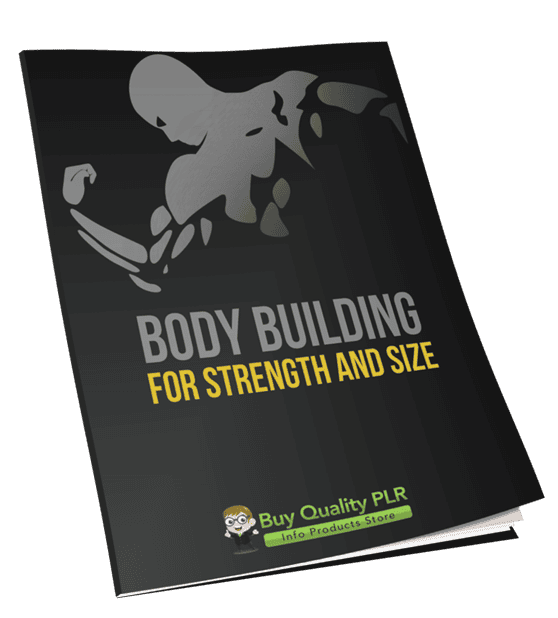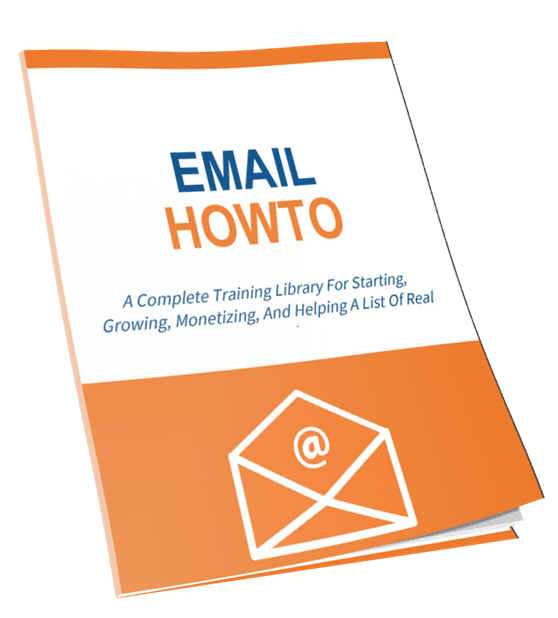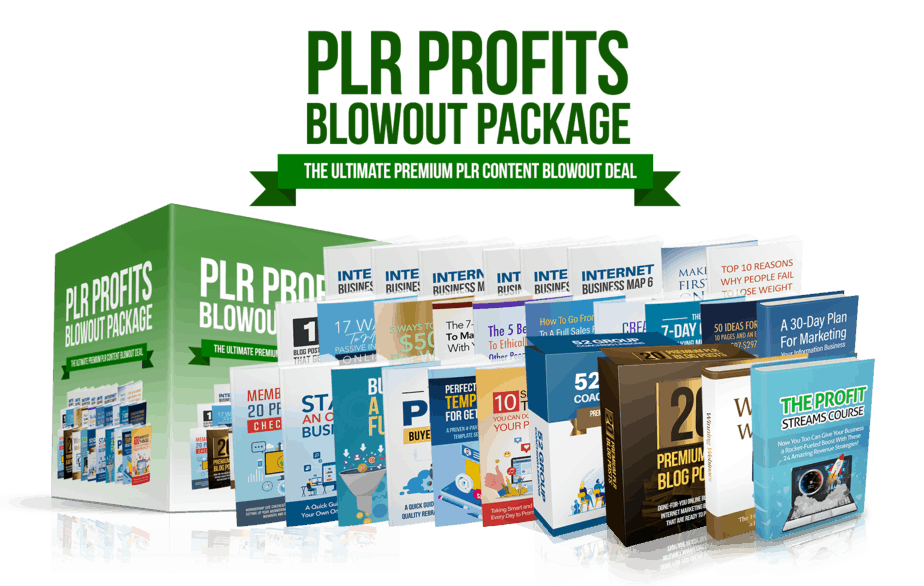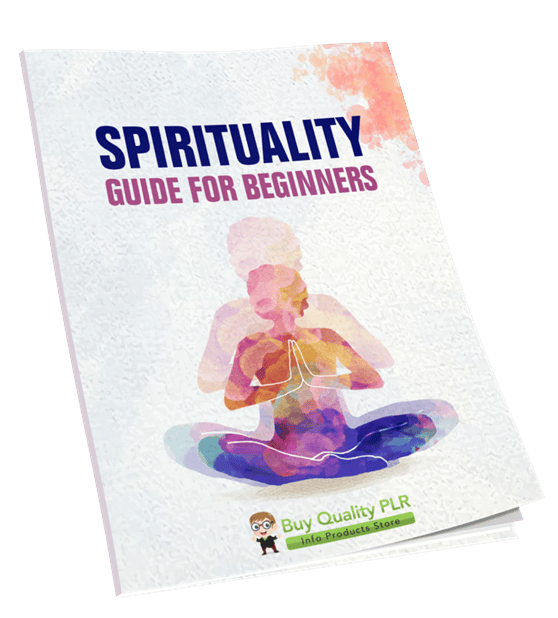
Spirituality Guide for Beginners PLR Course 25k Words
in Mindset PLR , Mindset PLR eBooks , PLR Checklists , PLR eBooks , PLR eCourses , PLR List Building Reports , Premium PLR , Premium PLR eBooks , Premium PLR Reports , Premium White Label Brandable PLR Coaching Courses , Private Label Rights Products , Self Improvement PLR , Self Improvement PLR Ebooks , Spiritual PLRChoose Your Desired Option(s)
has been added to your cart!
have been added to your cart!
#spiritualityguide #mindsetgrowth #wellnessmarketing #selfimprovement #plrcontent #innerpeace #personaldevelopment #plrcourse
Spirituality Guide for Beginners PLR Course – Your Path to Inner Peace and Growth
Unlock the secrets to inner peace, self-discovery, and spiritual growth with our comprehensive Spirituality Guide for Beginners PLR Course. Designed for beginners, this step-by-step training program provides actionable guidance to help you—or your audience—connect with the inner self, explore spirituality in a practical way, and integrate meaningful practices into daily life.
Whether you’re a wellness coach, blogger, digital entrepreneur, or content creator, this PLR course gives you ready-to-use materials to educate, inspire, and empower your audience—while creating a profitable digital product for your business.
Presenting…
Spirituality Guide for Beginners PLR Course 25k Words
Why Spirituality Matters
In our fast-paced world, many people feel disconnected, stressed, or overwhelmed. Spirituality is a tool that helps individuals:
- Find balance between mind, body, and soul
- Gain clarity and purpose in their lives
- Improve emotional resilience and inner calm
- Reduce stress and anxiety through mindfulness and reflection
- Foster meaningful connections with themselves, others, and the universe
With this PLR course, you provide your customers with a roadmap to explore spirituality confidently, even if they are complete beginners.
Course Overview
Spirituality Guide for Beginners PLR Course is 23,781 words of premium content, divided into 5 in-depth modules. Each module includes 4 actionable steps, practical exercises, and reflection prompts, designed to guide learners progressively toward spiritual growth.
Here’s what your audience will gain from each module:
Module 1: Understanding Spirituality
Goal: Build a foundational understanding of spirituality and its benefits.
- Step 1: What is Spirituality?
Explore the meaning of spirituality, how it differs from religion, and why it is a deeply personal journey. - Step 2: Benefits of a Spiritual Path
Learn how spiritual exploration brings peace, clarity, purpose, and enhanced emotional well-being. - Step 3: Identifying Your Why
Reflect on why you’re drawn to spirituality and set intentions to guide your journey. - Step 4: Clearing Misconceptions
Address common myths and misunderstandings about spirituality to cultivate an open and curious mindset.
This module provides the clarity needed to embark on a spiritual journey without confusion or doubt.
Module 2: Connecting with Your Inner Self
Goal: Develop awareness, mindfulness, and self-connection.
- Step 1: Introduction to Mindfulness
Practice simple mindfulness exercises that help learners stay present and cultivate self-awareness. - Step 2: Journaling for Self-Reflection
Learn to use daily journaling prompts, such as “What brings me joy?” to discover authentic thoughts and emotions. - Step 3: Practicing Gratitude
Daily gratitude exercises help shift perspective and focus on the positive aspects of life. - Step 4: Embracing Silence
Guide learners to spend 5–10 minutes in quiet reflection, cultivating inner peace and connection with their true self.
This module emphasizes actionable practices that form the basis for spiritual growth.
Module 3: Exploring Spiritual Practices
Goal: Introduce practical methods to enhance spiritual health.
- Step 1: Meditation Basics
Teach different meditation techniques—guided, mantra, and breath-focused—and how to begin a simple 5-minute practice. - Step 2: The Power of Affirmations
Create personal affirmations for positivity and goal achievement, and learn how to incorporate them daily. - Step 3: Nature and Spirituality
Explore the calming and grounding effects of spending time outdoors and connecting with the natural world. - Step 4: Energy Cleansing Techniques
Simple rituals like smudging, using crystals, and visualization to remove negative energy from the mind and environment.
Learners will leave this module equipped to integrate spiritual exercises into their routine confidently.
Module 4: Understanding Universal Energy
Goal: Deepen spiritual awareness by understanding energy and intuition.
- Step 1: What Is Universal Energy?
Explore the concept of energy connecting all living beings and how it influences daily life. - Step 2: Chakras and Energy Centers
Learn about the seven chakras, their significance, and techniques to identify and unblock energy flow. - Step 3: Manifestation and Law of Attraction
Practice manifestation techniques through intention-setting and journaling, learning to attract positive experiences. - Step 4: The Role of Intuition
Develop the ability to trust inner guidance and make decisions aligned with personal values and spiritual goals.
This module provides a practical introduction to energy work and intuitive decision-making.
Module 5: Integrating Spirituality into Daily Life
Goal: Make spirituality a lived experience, not just a practice.
- Step 1: Creating a Daily Routine
Establish morning or evening rituals, such as meditation, affirmations, or journaling, to anchor spiritual practice in everyday life. - Step 2: Acts of Kindness and Compassion
Learn to cultivate compassion through daily small acts that enrich both self and others. - Step 3: Finding Your Spiritual Tribe
Guide learners to seek supportive communities—online or offline—to share experiences and grow spiritually. - Step 4: Continuous Learning and Growth
Encourage lifelong learning through books, courses, and spiritual teachings while celebrating personal progress.
By the end of this module, learners will have a clear roadmap to live a spiritually aligned and fulfilling life.
Additional Materials Included
To make launching this course simple and profitable, we’ve included ready-to-use resources:
- Spirituality Guide for Beginners – Checklist (468 words): Practical steps for daily implementation and habit formation.
- Spirituality Guide for Beginners – FAQs (1,242 words): Answers to common questions and guidance for overcoming beginner challenges.
- Spirituality Guide for Beginners – Salespage (739 words): A professionally written sales page ready to use for promotion.
These extras save you time, ensuring you can go to market immediately with a professional, complete package.
How You Can Use and Profit from This PLR Course
Spirituality Guide for Beginners PLR provides multiple revenue-generating opportunities:
- Sell as a Complete Digital Course
Offer it as an eCourse on platforms like Teachable, Kajabi, or Thinkific. - Create Mini-Guides
Break modules into individual reports or guides and sell for $10–$20 each. - Bundle for Premium Packages
Combine with other wellness or self-improvement PLR products to create high-value bundles ($47–$97). - Launch a Membership Site
Use it to provide exclusive content to subscribers on a spiritual wellness membership platform. - Convert Into Multimedia
Transform the course into audio files, video lessons, slide decks, or interactive PDFs. - Lead Magnets and Email Campaigns
Use modules or excerpts to create valuable free content that grows your email list. - Flip and Resell
Brand it, add value, and sell as a digital product or site for high-ticket, one-time profits.
Why Buy This PLR Course
- Premium Ready-to-Use Content: 23,781 words of professionally written material.
- Highly Editable: Customize content, design, and branding to suit your audience.
- Evergreen Niche: Spirituality is a growing, timeless topic with widespread appeal.
- Multiple Income Streams: Perfect for courses, memberships, digital downloads, or blog content.
- Quick Launch: All modules, checklists, FAQs, and sales page included—go to market instantly.
License Terms
Permissions:
- Sell, edit, and rebrand the content.
- Use it for standalone courses, reports, or as part of bundles.
- Convert into audio, video, or membership content.
- Use as lead magnets, newsletter content, or blog posts.
Restrictions:
- Cannot pass on PLR rights to customers.
- Cannot give away the full course for free in original form.
- Maximum affiliate commission: 75% if used in affiliate marketing.
Take Action Today!
With the Spirituality Guide for Beginners PLR Course, you can:
- Empower beginners to embark on a fulfilling spiritual journey
- Build a profitable digital product in the personal growth niche
- Save weeks of content creation with ready-made, high-quality materials
Next Steps:
- Download the PLR package immediately.
- Customize and brand the course for your target audience.
- Start selling, creating memberships, or using it as a lead magnet.
Your customers are seeking guidance, clarity, and a practical path to spiritual well-being. Provide them with the tools they need while building your business in a lucrative, evergreen niche.
has been added to your cart!
have been added to your cart!
Here A Spirituality Guide for Beginners PLR Course
Welcome to your journey of spiritual exploration! This course is designed for beginners who wish to understand spirituality in a practical and meaningful way. Through these five modules, you’ll gain clarity, learn practical techniques, and discover insights to connect with your inner self and the universe.
Module 1: Understanding Spirituality
Step 1: What is Spirituality?
Spirituality is a vast and deeply personal concept that touches on how we find meaning, purpose, and connection in life. It’s often misunderstood or confused with religion, but it is much broader and can exist outside of any religious framework. Let’s explore this step-by-step to ensure a clear understanding that can resonate with diverse international audiences.
1.1. Understanding the Concept of Spirituality
Spirituality refers to the search for meaning, purpose, and connection to something greater than ourselves. This “something greater” could be:
- The universe
- A divine force or higher power
- Inner peace or self-awareness
- A sense of interconnectedness with all living beings
Why it matters:
Spirituality answers fundamental questions like:
- Why am I here?
- What gives my life meaning?
- How can I live authentically and harmoniously?
While religion often provides structured answers to these questions, spirituality is more fluid and individualistic.
1.2. Differentiating Spirituality from Religion
Religion is typically organized around:
- A defined set of beliefs and doctrines.
- Rituals and practices that are consistent among members of a group.
- Sacred texts or teachings.
- A shared community of followers.
Spirituality, on the other hand:
- Is often self-directed and unstructured.
- Emphasizes personal experience and exploration over adherence to rules.
- Can exist both within and outside religious traditions.
- Invites individuals to create their unique path based on their beliefs, values, and experiences.
For example:
- A religious person might find spirituality through prayer, attending a place of worship, or following specific teachings.
- A non-religious person might find spirituality through meditation, spending time in nature, or acts of kindness.
Key takeaway:
Religion and spirituality can overlap but are not the same. Understanding this distinction is crucial for connecting with a diverse audience.
1.3. Tailoring Spirituality to Your Beliefs and Values
One of the most empowering aspects of spirituality is its adaptability. Unlike rigid systems, spirituality allows you to:
- Define your own principles and what resonates with you.
- Embrace practices that align with your personal values.
- Reject ideas or practices that don’t feel authentic to you.
Actionable Tips:
- Reflect on your core values. Ask yourself: What truly matters to me in life?
- Explore different practices (e.g., meditation, yoga, journaling) to see what feels natural.
- Be open to evolving your spiritual beliefs as you grow and learn.
Example for clarity:
Imagine two individuals:
- Person A believes in a higher power and finds comfort in gratitude journaling.
- Person B doesn’t follow any deity but feels connected to life’s energy through mindfulness walks in nature.
Both are embracing spirituality in their unique ways, tailored to their beliefs.
1.4. Spirituality as a Personal Journey
Your spiritual path is deeply personal and ever-changing. There’s no universal roadmap, but there are guideposts:
- Start small: Introduce one simple practice, like daily reflection or mindful breathing.
- Stay curious: Read about diverse spiritual philosophies or attend workshops.
- Be kind to yourself: There’s no “right” way to be spiritual. Honor your journey.
Reflection Exercise for Course Creators:
Ask your learners to take 5 minutes to reflect and write:
- What does spirituality mean to me?
- How do I currently connect with my inner self or the world around me?
Encourage them to share their reflections if they feel comfortable, fostering a sense of community and shared understanding.
Summary of Step 1
- Spirituality is about seeking meaning, connection, and purpose.
- It differs from religion in that it’s flexible, individualistic, and often self-directed.
- Each person’s spiritual journey is unique and evolves over time.
By grasping the core ideas of spirituality and its distinction from religion, you lay a strong foundation for exploring deeper practices in subsequent steps of this course.
Top of Form
Bottom of Form
Step 2: Benefits of a Spiritual Path
Embarking on a spiritual journey offers profound benefits that go beyond surface-level happiness. It can lead to a sense of inner peace, clarity, and purpose, while also equipping individuals with tools to navigate stress and challenges in life. In this step, we’ll explore the transformative power of spirituality in a detailed, structured way.
2.1. Spirituality Brings Inner Peace
Inner peace is one of the most noticeable benefits of adopting a spiritual practice. Spirituality provides a sanctuary for the mind, enabling individuals to:
- Let go of overthinking and embrace stillness.
- Find comfort and calm even in chaotic situations.
- Develop a deeper sense of acceptance for life’s ups and downs.
How this works:
- Regular practices like meditation, prayer, or mindfulness help quiet the mental chatter.
- Focusing on the present moment reduces anxiety about the past or future.
Example in practice:
Consider someone overwhelmed by a high-stress job. By integrating 10 minutes of meditation into their daily routine, they might experience reduced tension and greater emotional balance.
Actionable Exercise for Learners:
Guide participants through a short 5-minute breathing exercise to demonstrate how focusing on the breath can bring a sense of calm.
2.2. Spirituality Provides a Sense of Purpose
Having a sense of purpose transforms life from mundane to meaningful. Spirituality helps individuals:
- Connect with their higher goals and values.
- Feel guided by something larger than themselves, whether it’s a divine force, the universe, or a deep inner calling.
- Align daily actions with long-term aspirations, making every moment intentional.
Why purpose matters:
- People with a strong sense of purpose are more resilient during tough times.
- They’re motivated to contribute positively to their communities or the world at large.
Reflection for Learners:
Ask participants to journal:
- What drives me to get out of bed in the morning?
- How can I align my current actions with what truly matters to me?
Encourage them to revisit these reflections as their spiritual journey evolves.
2.3. Spirituality Brings Clarity
Clarity arises when we quiet external noise and focus inward. Spirituality sharpens focus and improves decision-making by:
- Encouraging introspection and self-awareness.
- Helping individuals recognize what is truly important versus distractions.
- Offering a framework to process emotions and thoughts constructively.
How this helps:
- Individuals learn to trust their intuition and make decisions aligned with their values.
- They gain a clearer understanding of themselves, their relationships, and their goals.
Practical Tip for Course Creators:
Introduce a guided visualization exercise where participants imagine their “ideal self.” Prompt them to explore how that version of themselves acts, feels, and makes decisions.
2.4. Spirituality Helps Manage Stress and Challenges
Life’s challenges are inevitable, but spirituality provides a toolkit to face them with grace and resilience. It equips individuals to:
- Reframe negative experiences as opportunities for growth.
- Develop patience and perseverance in difficult situations.
- Build emotional resilience through practices like gratitude, mindfulness, and prayer.
Example:
Imagine someone facing financial difficulties. Through a gratitude practice, they might shift their focus from scarcity to appreciating what they do have, cultivating a more positive outlook.
Why it works:
- Spirituality emphasizes a bigger picture, which reduces feelings of helplessness.
- Practices like mindfulness create a buffer between a person and their stressors, allowing for better emotional regulation.
Interactive Activity for Learners:
- Provide a list of common stressors and ask participants to write one spiritual practice they could use to cope with each (e.g., meditation for anxiety, gratitude journaling for frustration).
Key Takeaways from Step 2
- Peace: Spirituality calms the mind and fosters emotional stability.
- Purpose: It brings meaning and alignment to daily actions.
- Clarity: Spirituality helps individuals gain deeper self-awareness and make intentional choices.
- Resilience: It provides tools to navigate life’s stress and challenges with a balanced perspective.
By understanding and experiencing these benefits, participants can see how integrating spirituality into their lives can lead to lasting transformation. This step not only motivates them to continue their journey but also provides actionable ways to begin reaping these rewards immediately.
Step 3: Identifying Your Why
A key part of any transformative journey is understanding why you’re embarking on it in the first place. In this step, we’ll guide learners through the process of reflecting on their motivations for exploring spirituality and setting clear, personal intentions for their spiritual path. This foundation will help make the journey meaningful and focused.
3.1. Reflecting on Your Motivations for Exploring Spirituality
Begin by taking time to reflect on why spirituality matters to you. Asking “why” brings clarity to your goals and allows you to connect more deeply with the process.
Questions to consider:
- Are you seeking peace or relief from stress?
- Do you want a greater sense of connection to others or the universe?
- Are you exploring spirituality as a way to heal, grow, or find purpose?
How to reflect effectively:
- Find a quiet space where you won’t be disturbed.
- Take 10-15 minutes to journal your thoughts on what drew you to spirituality.
- Be honest with yourself—there are no right or wrong answers.
Example Reflection:
A participant might write:
“I’ve been feeling disconnected from my daily life. I want to understand myself better and feel a deeper connection to the world around me.”
3.2. Understanding the Power of “Why”
Your “why” serves as the compass for your spiritual journey. When challenges arise or progress feels slow, returning to your reasons for starting can re-energize and refocus you.
Why is this important?
- Knowing your “why” creates meaning and direction.
- It prevents your journey from becoming a series of random, unfocused practices.
- It helps you measure progress in ways that are personal and fulfilling.
Activity for Course Creators:
Encourage learners to write down their “why” and keep it somewhere they’ll see regularly—on their phone, in a journal, or even as a note by their bedside.
3.3. Setting Intentions for Your Spiritual Journey
Once you’ve identified your “why,” the next step is to translate it into intentions. Intentions are clear statements about what you hope to achieve or experience through your spiritual practices.
How to set intentions:
- Use your “why” as a guide. If your “why” is about finding peace, your intention might focus on creating a daily mindfulness practice.
- Be specific but flexible. Intentions should be clear but allow room for growth and adjustment.
Examples of intentions:
- “I intend to start each day with 5 minutes of gratitude reflection.”
- “I intend to practice patience and kindness in my interactions with others.”
- “I intend to explore meditation as a tool for managing stress.”
Reflection Exercise:
Ask learners to write 1-3 intentions for their journey. Share the following prompts to inspire them:
- What do you hope to gain from this experience?
- How do you want to grow or change?
- What habits or practices could support these goals?
3.4. Aligning Intentions with Daily Life
Setting intentions is powerful, but aligning them with your daily life is where the real transformation happens. Integrating your intentions into your routine makes them actionable and sustainable.
Practical steps to alignment:
- Start small. Choose one intention to focus on initially.
- Create reminders. Use tools like calendar alerts or sticky notes to keep your intentions top of mind.
- Reflect daily. At the end of each day, spend a few minutes reviewing how well you aligned with your intentions.
Example of alignment:
If your intention is to cultivate gratitude, you might start by listing three things you’re grateful for each morning. Over time, this practice can shift your mindset toward positivity.
Interactive Activity:
Guide learners in creating a “daily intention checklist.” Include:
- The intention (e.g., “Practice mindfulness”)
- A simple daily action to fulfill it (e.g., “Spend 5 minutes meditating”)
- A reflection prompt to track progress (e.g., “How did I feel after meditating today?”)
Key Takeaways from Step 3
- Reflecting on your “why” gives clarity and purpose to your spiritual journey.
- Setting clear intentions transforms your motivations into actionable goals.
- Aligning intentions with daily life ensures they are practical and sustainable.
By identifying their “why” and setting meaningful intentions, learners lay a strong foundation for growth and transformation. This step empowers them to navigate their spiritual journey with focus and authenticity.
Step 4: Clearing Misconceptions
Misconceptions about spirituality can create unnecessary barriers for those starting their journey. In this step, we’ll address common myths, debunk them with evidence and reasoning, and guide learners in cultivating an open, curious mindset to explore new perspectives.
4.1. Identifying Common Myths About Spirituality
Many people hesitate to explore spirituality due to misunderstandings. Let’s identify and clarify some of the most prevalent myths:
Myth 1: Spirituality is the same as religion.
- Reality: While religion often includes spirituality, they are not synonymous. Spirituality is a personal journey focused on connecting with oneself, others, or the universe, independent of structured beliefs.
Myth 2: Spirituality requires a specific practice or lifestyle.
- Reality: There’s no “one-size-fits-all” in spirituality. It can include meditation, nature walks, journaling, or even daily gratitude practices.
Myth 3: Spirituality is only for the deeply introspective or isolated.
- Reality: Spirituality is for everyone, including those with active social lives or fast-paced careers.
Activity for Course Creators:
Create a quick “Myth vs. Reality” quiz for learners to assess their preconceived notions and clarify any misunderstandings.
4.2. Exploring the Origins of Misconceptions
Understanding where misconceptions come from can help learners overcome them.
Sources of common myths:
- Cultural norms: Some cultures equate spirituality with strict religious adherence.
- Media portrayal: Stereotypes often depict spirituality as overly mystical or impractical.
- Lack of exposure: Without firsthand experience, people may rely on inaccurate assumptions.
Reflection Exercise for Learners:
Ask participants to consider:
- What have I believed about spirituality, and where did those beliefs come from?
- How have those beliefs impacted my willingness to explore spirituality?
By reflecting, learners can identify mental blocks and start releasing them.
4.3. Shifting to an Open and Curious Mindset
Creating a mindset open to new perspectives is crucial for meaningful exploration. An open mindset encourages growth and self-discovery.
Steps to foster openness:
- Acknowledge biases: Everyone has them. The key is recognizing and challenging them.
- Adopt a “beginner’s mind:” Approach spirituality as a curious learner, free from judgment or preconceived notions.
- Embrace experimentation: Be willing to try different practices, even if they feel unfamiliar initially.
Example:
If a learner feels skeptical about meditation, encourage them to try it for just 5 minutes. Remind them that spirituality is about personal experience, not rigid rules.
Guided Visualization Activity:
Lead learners through a short visualization where they imagine themselves as explorers entering a vast, beautiful forest. Each path in the forest represents a new perspective or practice. Encourage them to feel curious and excited about the possibilities.
4.4. Building Confidence to Explore Spirituality
Overcoming misconceptions and opening the mind builds the confidence to embark on a spiritual path. Confidence helps learners:
- Take ownership of their journey.
- Stay resilient when facing doubts or challenges.
- Embrace their unique approach without comparison or fear of judgment.
Strategies to build confidence:
- Celebrate small wins: Encourage learners to acknowledge their progress, no matter how small.
- Create a supportive environment: Remind learners that spirituality is deeply personal—there’s no “right” or “wrong” way.
- Encourage reflection: Regularly revisit intentions and goals to see how far they’ve come.
Activity for Course Creators:
Have learners write a short affirmation to bolster their confidence, such as:
- “I am open to new experiences and trust my journey.”
- “I release fear and embrace growth.”
Ask them to repeat this affirmation daily as they continue their exploration.
Key Takeaways from Step 4
- Misconceptions about spirituality, such as equating it with religion, can create unnecessary barriers.
- Understanding the origins of myths helps learners identify and challenge their assumptions.
- Cultivating an open and curious mindset encourages exploration and growth.
- Building confidence through small wins and affirmations empowers learners to navigate their journey authentically.
By clearing misconceptions, learners can approach spirituality with clarity and openness, making their journey more authentic and rewarding.
We’re also giving these extra bonuses
Spirituality Guide for Beginners – Checklist
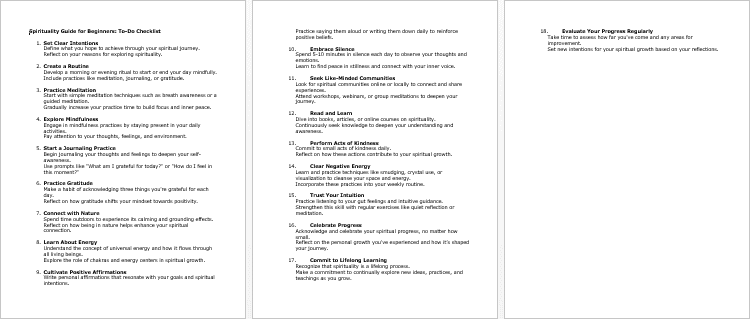
Spirituality Guide for Beginners – FAQs

Spirituality Guide for Beginners – Salespage Content

Package Details:
Word Count: 23 781 Words
Number of Pages: 91
Spirituality Guide for Beginners – Bonus Content
Checklist
Word Count: 468 words
FAQs
Word Count: 1242 words
Salespage Content
Word Count: 739 words
Total Word Count: 26 230 Words
Your PLR License Terms
PERMISSIONS: What Can You Do With These Materials?
Sell the content basically as it is (with some minor tweaks to make it “yours”).
If you are going to claim copyright to anything created with this content, then you must substantially change at 75% of the content to distinguish yourself from other licensees.
Break up the content into small portions to sell as individual reports for $10-$20 each.
Bundle the content with other existing content to create larger products for $47-$97 each.
Setup your own membership site with the content and generate monthly residual payments!
Take the content and convert it into a multiple-week “eclass” that you charge $297-$497 to access!
Use the content to create a “physical” product that you sell for premium prices!
Convert it to audios, videos, membership site content and more.
Excerpt and / or edit portions of the content to give away for free as blog posts, reports, etc. to use as lead magnets, incentives and more!
Create your own original product from it, set it up at a site and “flip” the site for megabucks!
RESTRICTIONS: What Can’t You Do With These Materials?
To protect the value of these products, you may not pass on the rights to your customers. This means that your customers may not have PLR rights or reprint / resell rights passed on to them.
You may not pass on any kind of licensing (PLR, reprint / resell, etc.) to ANY offer created from ANY PORTION OF this content that would allow additional people to sell or give away any portion of the content contained in this package.
You may not offer 100% commission to affiliates selling your version / copy of this product. The maximum affiliate commission you may pay out for offers created that include parts of this content is 75%.
You are not permitted to give the complete materials away in their current state for free – they must be sold. They must be excerpted and / or edited to be given away, unless otherwise noted. Example: You ARE permitted to excerpt portions of content for blog posts, lead magnets, etc.
You may not add this content to any part of an existing customer order that would not require them to make an additional purchase. (IE You cannot add it to a package, membership site, etc. that customers have ALREADY paid for.)
Share Now!

